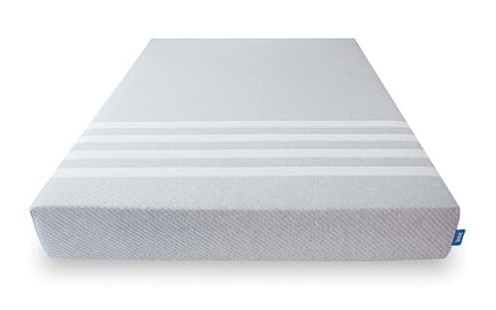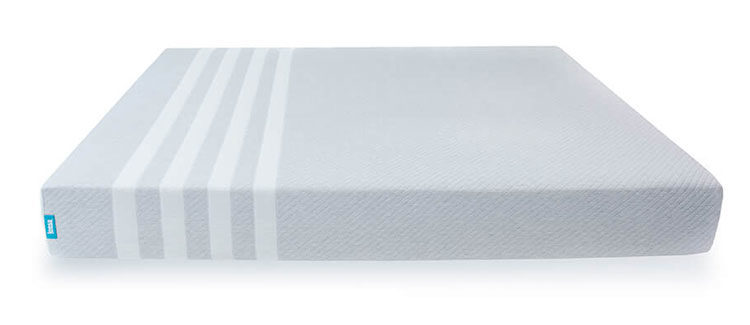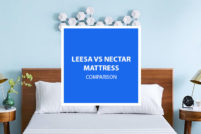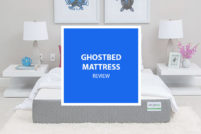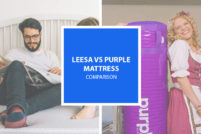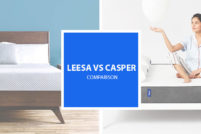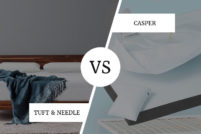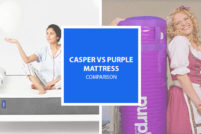When choosing a new mattress, the options seem rather limitless. A purchase can be quite confusing, particularly if you are opting to purchase your bed online, rather than from a brick and mortar store, where you can test the mattresses out.
When it comes to the Leesa Mattress versus the Tuft & Needle, on the outside, they do look the same. They are both ten inches high, they both are built with layers of foam and they are not that different, in price.
But dig a little deeper and there are some not so subtle differences that could mean the difference between years of comfortable slumber and an annoying return process.
We’ve done some deep dive research to break down the differences between these two mattresses-both great, but with some marked variances. One of the main differences between the Leesa and the Tuft & Needle mattresses is the construction.
While the Leesa Mattress opts for multi layered foam construction, with an Avena foam corrugated layer on the top, the Tuft & Needle design is a bit simpler, with only two layers. If you are looking for layers of specialty foam, between the two, Leesa is the winner.
From our research, we determined that the Tuft & Needle mattress is best suited for those of average weight who prefer a firmer mattress with no sinking in feeling.
If you are heavier or have problems with pressure points, you may find that the Leesa mattress is a better fit for you, which is adaptive and comfortable for most body types. Conversely, the Tuft & Needle mattress may be a bit firm for side sleepers if they are below average weight.
The Leesa mattress tends to be a good mattress for all styles of sleepers, whether they sleep on their back, stomach or side.
Furthermore, if you are a hot sleeper, the Leesa mattress might be a better choice for you than the Tuft & Needle. We will go into more details about these mattresses and their construction, below. Let’s get started!
Review: The Leesa Mattress
One of the standout features of the Leesa Mattress is how adaptive it is for most customers, regardless of their body weight or sleeping style. With multi layered construction and a bit of memory foam feel without being too hot, the Leesa Mattress is a favourite for many.
Pros & Cons of the Leesa Memory Foam Mattress:
Pros:
- Adaptive feel works for most body types
- Great for hot sleepers
- Little motion transfer
- High quality construction
- Good value and warranty
- Philanthropic business model
Cons:
- Might be too firm for side sleepers who are below average weight
- Might not be good for people prefer the sinking feeling of thick memory foam
- More expensive than the Tuft & Needle mattress
- Some off-gassing smell
You Might Want to Pick the Leesa Mattress If:
- You are overweight: If you are over 230 pounds you might find that the Leesa Mattress is just the bed you need to cushion your joints or pressure points. While its stable base layer means that it is supportive and firm, the bit of memory foam in the middle, plus the adaptive Avena foam top layer means this mattress has some soft cushioning without being too soft. Heavier people find that softer beds make them sink into much, and can also make them hot. The Leesa bed gives a floating on top feeling, and is rated as medium-firm but still comfortable.
- You sleep hot: While some mattresses use gimmicky materials in their mattresses, there seems to be something to the corrugated layer of Avena foam on the top of the Leesa mattress. The air pockets in the corrugated layer promote airflow and keep the mattress cool and having this layer above the memory foam layer means that customers don’t sink in too much and people that tend to sleep hot, are staying cool and dry. Customers who normally sleep hot are giving this mattress great feedback.
- You like a bit of memory foam but not too much: If you like the soft cushy feeling of memory foam but aren’t a fan of sinking deep into your bed, this mattress might be right for you. The Leesa Mattress has just two inches of memory foam, so it’s cushioning for the body while not being too soft. Customers overwhelmingly feel that this mattress adapts to the shape of the body, lending support and firmness, but also feeling soft on joints, including hips and shoulders.
The Leesa Mattress is a ten-inch-high foam mattress, built in three layers. The base layer is made from six inches of high density support foam. This lends to the low motion transfer of the bed and provides a stable and firm base for the layers above.
This bed is a great option if you are a light sleeper or if you have a partner who moves around a lot. Above this layer is a two-inch memory foam layer. This provides a softness that is what makes it great for most sleep positions.
How firm is it?
Because it is only a two-inch layer, it isn’t too soft and doesn’t have too much of a sinking in feel, but it provides enough cushioning that most who have joint and pressure point problems, are happy with this bed.
However, if you are someone who likes the sinking feeling of a thick and soft memory foam layer, this bed might be too firm for you. The top layer is one of the features that makes the Leesa bed so unique.
And is two-inch layer of Avena foam. Avena is a corrugated type of foam that is meant to be more durable and have more longevity, than latex. Best of all, is it is breathable, with air pockets throughout, making this a breathable and cool bed.
Reviews suggest that this mattress is medium firm and around a 6 or 7 on a 10 point scale of firmness, with 10 being the firmest.
Does it sleep hot?
Customers who complain about sleeping hot report that this bed doesn’t make them sink in too much, so they aren’t hot at night, and the Avena foam seems to make a big difference.
People that move around in different positions, in the night, are comfortable in this bed, even if they are over 230 pounds. For most people, it is adaptive and accommodating.
While the majority of customers are satisfied with purchasing the Leesa, overall with a few finding it a bit too firm and adding a mattress topper for extra comfort.
This is particularly the case with smaller people under 130 pounds, who may find this mattress a bit too firm if they sleep on their side.
This seems to be solved for most people by purchasing an extra mattress topper, but it’s something to keep in mind if you are a smaller customer.
Some customers report an off-gassing smell with this mattress that lasts a few days and dissipates fairly quickly.
While there aren’t any natural materials in this mattress, it is Certi-PUR US certified, meaning it doesn’t contain any toxic gases or dangerous chemicals.
What does the Leesa cost and is there a sleep trial?
The Leesa Mattress offers great value with a 10-year warranty and a 100-night sleep trial. This is on par with what the Tuft & Needle Mattress offers, but there is a slight difference in pricing, with the Leesa mattress being 200-300 USD more expensive, depending on their current offers and discounts.
While some mattresses have a much wider variance in pricing, this could be a big difference for some customers. Another thing that sets Leesa apart is their philanthropic business model.
Apart from being partnered with various charities, they donate one mattress for every ten sold and plant one tree for every mattress they move. If you’re looking to contribute to a company’s philanthropic efforts with your purchase, then the Leesa might be the more ethical choice.
Review: The Tuft & Needle
Last update on 2024-04-30 at 05:54 - More InfoProduct prices and availability are accurate as of the date/time indicated and are subject to change. Any price and availability information displayed on Amazon.com at the time of purchase will apply to the purchase of this product." / Affiliate links / Images from Amazon Product Advertising API
As we mentioned above, at first glance the Tuft & Needle Mattress looks very similar to the Leesa Mattress. Their Queen mattress comes in at the same 80” x 60” and they are both 10-inches high.
They are both made with foam layers but there is some difference in the construction and a slight variance in firmness and price, between the two.
Pros & Cons of the Tuft & Needle Mattress:
Pros:
- Bargain price
- Great warranty and sleep trial period
- Great for people who like firmer mattresses
- Good for hot sleepers
Cons:
- Might be too firm for some smaller people
- Might be too firm for heavier customers who sleep on their stomach
- Fairly simple construction with only two layers
- Some off-gassing smell
You Might Want to Pick the Tuft & Needle Mattress If:
- You are average weight: While the Tuft & Needle Mattress seems to be satisfying customers of most body types, overall, the people who seem to be the most comfortable are the averaged sized customer. A few customers who are heavier and sleep on their stomach have mentioned that this bed took some time to get used to and a few who sleep on their sides purchased an extra topper for the bed to relieve pressure points brought on by the firmness of this bed against their extra body weight. Overwhelmingly, though, most customers of all body types are satisfied.
- You sleep hot: Because this mattress is a bit on the firmer side, customers who sleep hot report being happy with this bed because they don’t sink in and there is no “hugging” feeling of soft memory foam. If you sleep hot, this could be a good choice for you, especially if you like a firmer mattress.
- You want a mattress with basic construction: Basic construction means savings and this mattress has two simple layers and few frills. Although the top layer of high density foam is proprietary, this mattress has pretty straight forward construction. If you are suspicious of technical foams and multiple layers and are just looking for a plain and simple foam mattress, with no memory foam, this could be the good choice for you.
- You are on a budget: You can’t beat the price of the Tuft & Needle mattress for the level of customer satisfaction. Priced well below mattresses of similar construction, not only is the mattress great for those on a budget, the company offers a great warranty and sleep trial period, as well. Put this together with a level of customer service that has many, many customers feeling enthusiastic and this mattress is a great buy, overall.
Like the Leesa, the Tuft & Needle mattress starts with a high density base layer of foam, making it a great choice for those who are concerned about motion transfer.
The base layer also provides a good layer of stability and support so that not only do couples who share the bed not wake each other up, but they don’t roll into the centre, either. However, the base layer of the Tuft & Needle mattress is 7 inches thick, as opposed to Leesa’s 6 inches.
On top of this is one more high density layer–a 3-inch layer of what they call their T&N Adaptive foam that is designed to be conforming but stay cool.
How firm is the Tuft & Needle bed?
Because of the simplicity of the construction of this mattress, it comes out as slightly firmer than the Leesa mattress. On a scale of 1 to 10 with 10 being the firmest, the Tuft & Needle mattress is about a 7 according to reviews and customer feedback. There is no memory foam layer in this mattress and very little sinking in feeling.
This makes it a great choice for hot sleepers as people tend to float on top of this style of mattress, rather than sinking in.
However, some customers find this mattress too firm and a few more require extra mattress toppers for this bed than they do with the Leesa mattress. If you love a firmer mattress, this could be the choice for you.
But some heavier customers over 230 pounds report that this bed wasn’t great for sleeping on their stomachs and some smaller customers under 130 pounds felt that this bed was too firm for them.
Others feel that this bed is a bit too firm for side sleeping and have mentioned sore shoulders. However, it is important to note that overwhelmingly, this mattress is satisfying most customers of all body types.
Do I get a sleep trial and good warranty?
Like the Leesa Mattress, the Tuft & Needle bed offers a great 10-year warranty and a 100-day sleep trial and while some customers report a slight off gassing smell, similar to the Leesa bed, the vast majority of customers report that this dissipates after a while.
And like the Leesa bed, the foam in the Tuft & Needle mattress is Certi-PUR US certified.
How much does the mattress cost?
Another thing that sets this mattress apart from the Leesa, apart from firmness and construction is the price. At a few hundred dollars less than the Leesa, this mattress is still in the same price family and a vast difference from mattresses priced at a few thousand dollars, but this difference could be a big deal for some people.
Our Verdict
The difference between the Leesa and the Tuft & Needle Mattress comes down to a bit of personal preference and budget. Both mattresses are on the medium firm end of the scale, with the Tuft & Needle being slightly firmer.
The Leesa mattress does have that bit of memory foam, so customers who are looking for a bit of memory foam “cushiness”, might prefer it over the Tuft & Needle.
As well, the Tuft & Needle mattress has a thicker base layer of foam and less layers on top of the base layer making for a firmer, more simpler construction. Some heavier customers report that the Tuft & Needle bed is a bit too firm for them, particularly if they are heavier stomach sleepers or smaller side sleepers.
However, most people are satisfied with both mattresses, no matter their body size with a few more buying mattress toppers for the the Tuft & Needle bed, than for the Leesa.
Both mattresses are keeping their customers cool due to the fact that they are slightly firm and don’t have much “sink”. They both have top layers of foam that are designed with coolness and mind and seem to work for most people with very few reporting that they are too hot.
They offer the same warranty and sleep trial and the Leesa mattress is priced at about 200-300 USD more, although there is some price fluctuation due to offers and discounts that Leesa periodically offers.
Overall, we would recommend the Leesa mattress for all body weights and sleep types who like a bit of memory foam feel and the Tuft & Needle for those who like a firmer bed and/or for those on a budget.
